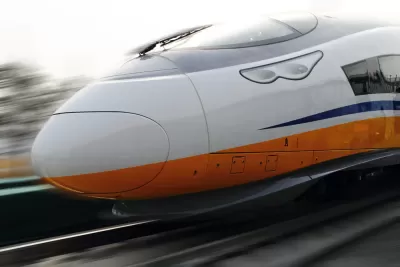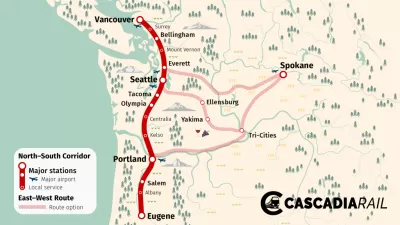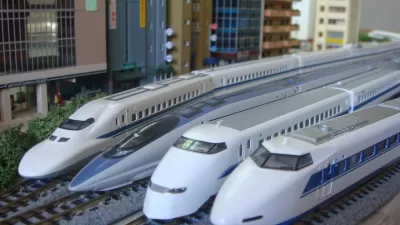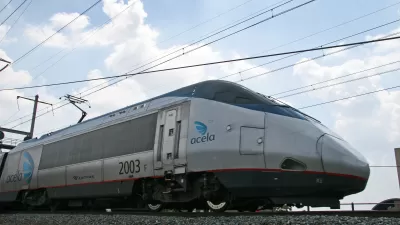High-speed rail advocates in the Pacific Northwest are pushing for a high-speed link between Vancouver, Seattle, and Portland to be part of future economic stimulus spending in the United States.

Martin Brosnan writes to anticipate and plan for economic recovery, returning to an idea that figured in the economic recovery plan for the previous recession, yet without much to show for it: high-speed rail.
After dispensing with the idea of repeating the mistakes of the country's history of car-centric economic stimulus spending, Brosnan suggests high-speed rail as a desirable approach to an infrastructure related economic stimulus:
High-speed rail, however, may be the way to go. A high-speed rail line from Portland, Oregon to Vancouver, British Columbia is the perfect project to provide hundreds of short- and long-term employment opportunities, stimulate the economy of one of North America’s top 10 most populated mega-regions, foster increased cooperation between the two nations post border-closure, and to help move people through the region and to new employment opportunities in an economy that may result in fewer people being able to afford personal vehicles. Looking back at the conception of the highway system, it seems to be the right time to invest in such a project–to accommodate large, and growing urban populations, create jobs and economic growth, and cut transportation costs.
As noted by Brosnan, some of the planning and political ground has already been cleared for a high-speed rail connection in Cascadia. There's also gathering political support federal high-speed rail spending from House Rep. Seth Moulton (D-Mass.), who has proposed a bill (complete with supplementary white paper) that would spend $250 million on high-speed rail as a form of economic relief in the wake of the pandemic. The Green New Deal would also support a shift in federal transportation policy toward rail, away from air and car travel.
FULL STORY: Should The Government Invest in High-Speed Rail to Boost a Post-Pandemic Economic Recovery?

Alabama: Trump Terminates Settlements for Black Communities Harmed By Raw Sewage
Trump deemed the landmark civil rights agreement “illegal DEI and environmental justice policy.”

Study: Maui’s Plan to Convert Vacation Rentals to Long-Term Housing Could Cause Nearly $1 Billion Economic Loss
The plan would reduce visitor accommodation by 25% resulting in 1,900 jobs lost.

Planetizen Federal Action Tracker
A weekly monitor of how Trump’s orders and actions are impacting planners and planning in America.

This Toronto Suburb Has More Bus Riders Than Columbus, Ohio
Brampton, Ontario used gradual improvements in service to prove that if you build it, they will ride.

Paris Bike Boom Leads to Steep Drop in Air Pollution
The French city’s air quality has improved dramatically in the past 20 years, coinciding with a growth in cycling.

Why Housing Costs More to Build in California Than in Texas
Hard costs like labor and materials combined with ‘soft’ costs such as permitting make building in the San Francisco Bay Area almost three times as costly as in Texas cities.
Urban Design for Planners 1: Software Tools
This six-course series explores essential urban design concepts using open source software and equips planners with the tools they need to participate fully in the urban design process.
Planning for Universal Design
Learn the tools for implementing Universal Design in planning regulations.
Smith Gee Studio
Alamo Area Metropolitan Planning Organization
City of Santa Clarita
Institute for Housing and Urban Development Studies (IHS)
City of Grandview
Harvard GSD Executive Education
Toledo-Lucas County Plan Commissions
Salt Lake City
NYU Wagner Graduate School of Public Service





























